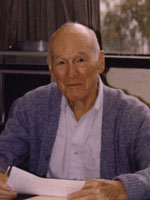
Paul D. Boyer
University of California at Los Angeles
The Nobel Path
Spirited exchange of ideas and open discussion are critical to the advance of science. I have long felt that the American research university is one of the finest features of our society because it fosters creative cooperation among well-trained scholars. Assembling a group of faculty, postdoctoral fellows, and graduate students to discuss experiments creates a marvelous venue for the development of new knowledge. The Gordon Conferences operate in the same way; in fact, they offer a regular meeting site for leading minds to discuss novel ideas over the course of many years.
I entered scientific research in 1939 as a graduate student in biochemistry at the University of Wisconsin. At the time I took for granted the excellence of the department; I did not realize how fortunate I was to be able to walk down the hall from my lab and listen to the symposium of Nobel laureates Otto Meyerhof, Fritz Lipmann, Carl Cori, and others talking about respiratory enzymes and the discovery of oxidative phosphorylation. Later I came to see just how much work it takes to make good scientific dialogue possible.
My interest in protein structure and function first arose through research I did on human serum during a postdoc at Stanford University. After my postdoctoral year I began teaching at the University of Minnesota. Like others in my generation, I got a boost from the end of World War II. Graduate students were flocking to the universities, and new federal funding was available for molecular biology. After seventeen years in Minnesota I accepted an offer in 1965 to serve as the initial director of the Molecular Biology Institute at the University of California at Los Angeles.
That same year I attended my first Gordon Research Conference, called Energy Coupling Mechanisms. There are many competing meetings now, but for thirty years the Energy Coupling Mechanisms GRC was the premier way to communicate in the field. Every scientist doing pioneer work wanted to attend. In fact, the European Bioenergetics Conference series was started by GRC attendees and intentionally alternated years with the Energy Coupling Mechanisms GRC. Together, these meetings inspired a wave of breakthrough research in biology.
At my first GRC I presented results showing a previously unknown pathway for adenosine triphosphate (ATP) synthesis. Throughout nature, energy derived from sunlight or the use of oxygen is captured to make ATP, which is then used to drive many essential biological processes, such as muscle contraction, brain and nerve function, and the syntheses of protein and DNA. I mistakenly presented our results as the primary route for ATP formation. Some conference participants aptly questioned this interpretation, which stimulated our further studies showing that what we had found was a minor pathway for ATP synthesis. The major pathway remained tantalizingly unknown.
In the early 1970s we were still trying to find out how most ATP was made. Advances in bioenergetics showed that a complex enzyme called ATP synthase was involved. Earlier data led me to propose a new concept for ATP formation: that the major use of energy is not in the formation of ATP but rather in releasing tightly bound ATP that was readily formed at the catalytic site of the ATP synthase.
In 1970 I started participating in another GRC series called Enzymes, Coenzymes, and Metabolic Pathways. This conference was more general in scope but included sessions about ATP formation, and many of its attendees provided valuable appraisals of my research. Participation in both series played a vital role in our identification of the binding change mechanism for ATP synthesis, which involves three identical catalytic sites that participate sequentially in substrate binding, the formation of tightly bound ATP, and finally ATP release.
In 1981 findings in my laboratory and by others led me to propose that the binding changes of the catalytic sites were driven by the rotation of a centrally located subunit. We did not publish much on rotational catalysis at first because we had already communicated the idea to most of the important scientists in the field at Gordon Conferences. Through good fortune, at the 1981 Bioenergetics GRC, John Walker presented his preliminary studies on the X-ray structure of ATP synthase. Walker and I kept in touch, and it was gratifying when his structural results published in 1994 strongly supported the binding change mechanism with rotational catalysis. Walker and I shared half the 1997 Nobel Prize in chemistry for understanding of this mechanism.
With increasing specialization in science fewer opportunities arise to learn about important findings in allied fields. Although specialization is an inevitable result of growth in knowledge, it can become counterproductive by causing us to lose perspective on neighboring areas relevant to our work. Gordon Conferences present a solution to this side effect: they are structured in a way that promotes informal discussion alongside formal sessions and keeps us talking to our colleagues. In the future I hope GRC continues to hold fields together and broaden our research interests.